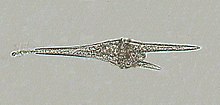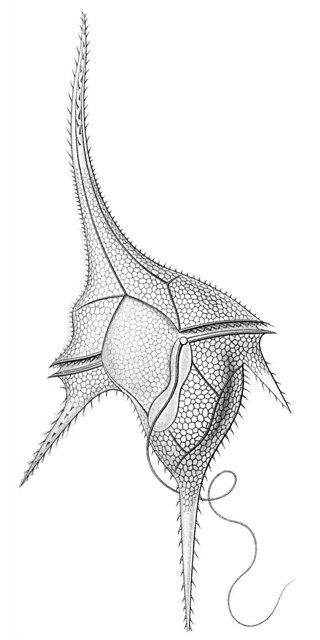
The dinoflagellates are a monophyletic group of single-celled eukaryotes constituting the phylum Dinoflagellata and are usually considered protists. Dinoflagellates are mostly marine plankton, but they also are common in freshwater habitats. Their populations vary with sea surface temperature, salinity, and depth. Many dinoflagellates are photosynthetic, but a large fraction of these are in fact mixotrophic, combining photosynthesis with ingestion of prey.

The Integrated Taxonomic Information System (ITIS) is an American partnership of federal agencies designed to provide consistent and reliable information on the taxonomy of biological species. ITIS was originally formed in 1996 as an interagency group within the US federal government, involving several US federal agencies, and has now become an international body, with Canadian and Mexican government agencies participating. The database draws from a large community of taxonomic experts. Primary content staff are housed at the Smithsonian National Museum of Natural History and IT services are provided by a US Geological Survey facility in Denver. The primary focus of ITIS is North American species, but many biological groups exist worldwide and ITIS collaborates with other agencies to increase its global coverage.

The furcula, or furca is a forked, tail-like appendage. It is present in most species of springtails, and in them it is attached ventrally to the fourth abdominal segment. The organ most often is present in species of Collembola that lives in the upper soil layers where it is used for jumping to avoid predators. While at rest, it is retracted under the abdomen and held there by a structure variously called the retinaculum or hamula, which in turn is located beneath the third abdominal segment. When the furcula escapes from retinaculum, it swings downwards and hits the substrate, propelling the springtail into the air. The animal does not use this mechanism for ordinary locomotion, but only for escaping from predators or severe stress.
The Ethiopian long-eared bat or Ethiopian big-eared bat is a species of long-eared bat in the family Vespertilionidae.

Homopus is a genus of tiny tortoises in the family Testudinidae, endemic to southern Africa. Three species have been moved to the genus Chersobius.
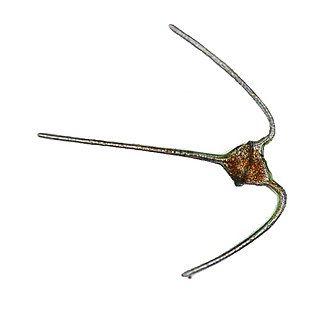
The genus Ceratium is restricted to a small number of freshwater dinoflagellate species. Previously the genus contained also a large number of marine dinoflagellate species. However, these marine species have now been assigned to a new genus called Tripos. Ceratium dinoflagellates are characterized by their armored plates, two flagella, and horns. They are found worldwide and are of concern due to their blooms.
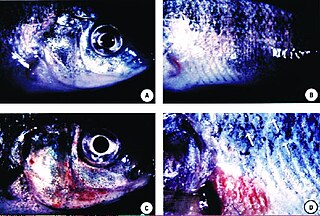
Predatory dinoflagellates are predatory heterotrophic or mixotrophic alveolates that derive some or most of their nutrients from digesting other organisms. About one half of dinoflagellates lack photosynthetic pigments and specialize in consuming other eukaryotic cells, and even photosynthetic forms are often predatory.
Arhythmacanthidae is a family of parasitic worms from the order Echinorhynchida.

Pomphorhynchidae is a family of parasitic worms from the order Echinorhynchida.

Eptatretus deani, the black hagfish, is a species of hagfish.
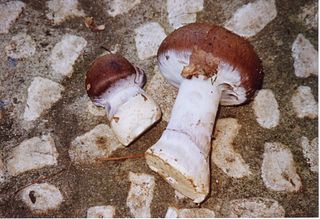
Cortinarius praestans, also known as the goliath webcap, is a basidiomycete mushroom of the genus Cortinarius. The mushroom has orangish-yellow caps that reach up to 20 cm (7.9 in) in diameter, and thick club-shaped stipes up to 15 cm (5.9 in) long. The edible mushroom is found in Europe.
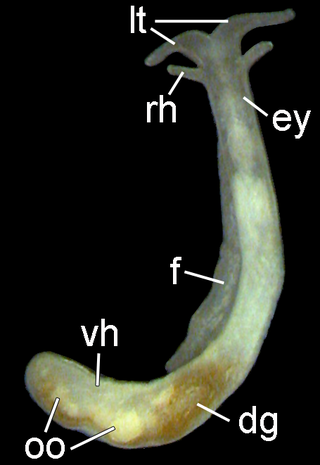
Pseudunela marteli is a species of sea slug, an acochlidian, a shell-less marine gastropod mollusk in the family Pseudunelidae.

Diuronotus aspetos is a species of large sized meiofaunal chaetonotid gastrotrich found in the North Atlantic. With Diuronotus rupperti, it is one of the only two species representing the genus Diuronotus.
Meroselenidium is a genus of parasitic alveolates in the phylum Apicomplexa. Species in this genus infect marine invertebrates.

Furca is an extinct genus of marrellomorph arthropod known from the Sandbian stage of the Czech Republic, with a single currently described species, Furca bohemica. A tentative additional species, "Furca mauretanica": was proposed for specimens discovered in Morocco, but this species remains a nomen nudum until formally published, and probably belongs in a new separate genus.
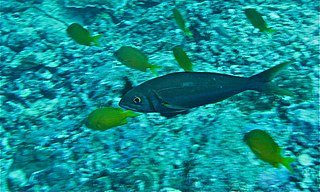
Aphareus furca, the small toothed jobfish, blue smalltooth jobfish, fork-tailed snapper or snapper jobbyfish is a species of marine ray-finned fish, a snapper belonging to the family Lutjanidae. It is found in the Indo-Pacific region.

Amblygaster sirm, the spotted sardinella, also known as the northern pilchard, spotted pilchard, spotted sardine, and trenched sardine, is a reef-associated marine species of sardinellas in the herring family Clupeidae.

Tripos is a genus of marine dinoflagellates in the family Ceratiaceae. It was formerly part of Ceratium, then separated out as Neoceratium, a name subsequently determined to be invalid.

Dinoflagellates are eukaryotic plankton, existing in marine and freshwater environments. Previously, dinoflagellates had been grouped into two categories, phagotrophs and phototrophs. Mixotrophs, however include a combination of phagotrophy and phototrophy. Mixotrophic dinoflagellates are a sub-type of planktonic dinoflagellates and are part of the phylum Dinoflagellata. They are flagellated eukaryotes that combine photoautotrophy when light is available, and heterotrophy via phagocytosis. Dinoflagellates are one of the most diverse and numerous species of phytoplankton, second to diatoms.
C. Susan Weiler is an aquatic scientist known for developing mentoring programs for scientists as they navigate the transition from student to independent researcher.
